Difference between revisions of "GPU621/VTuners"
(→Algorithm Optimization) |
(→Algorithm Optimization) |
||
| Line 21: | Line 21: | ||
== Algorithm Optimization == | == Algorithm Optimization == | ||
| + | |||
| + | [[File:Flame Graph.png|600px|frame|Flame Graph: This is an example of a flame graph selecting the “hottest” processes run in an application which represent 93.3% of the total CPU usage time]] | ||
| + | [[File:Hotspot Analysis.png|600px|frame|Vtune Summary: Here we can see the summary of the output of the Vtune Profiler which shows some general information about the run time and thread usage]] | ||
=== Analyzing Hot Code Paths === | === Analyzing Hot Code Paths === | ||
==== Flame Graphs ==== | ==== Flame Graphs ==== | ||
| − | |||
| − | |||
The Intel Vtune Profiler provides flame graphs to display a representation of stacks and stack frames in an application. All functions in an application are plotted on a graph and the associated stack depth is represented as height on the y-axis and the width of the bar represents the amount of CPU usage time. The “hottest” functions in an application are then the widest parts on the flame graph. | The Intel Vtune Profiler provides flame graphs to display a representation of stacks and stack frames in an application. All functions in an application are plotted on a graph and the associated stack depth is represented as height on the y-axis and the width of the bar represents the amount of CPU usage time. The “hottest” functions in an application are then the widest parts on the flame graph. | ||
=== Analyzing Hot Spots === | === Analyzing Hot Spots === | ||
| − | |||
| − | |||
==== Hotspot Analysis ==== | ==== Hotspot Analysis ==== | ||
| − | + | The Hotspot analysis feature in the Intel Vtune Profiler allows you to dig deeper into your application and identify pieces of code which are taking a long time to execute. These hot spots can be used to identify problem areas in your application and help improve performance. | |
== Microarchitecture and Memory Bottlenecks == | == Microarchitecture and Memory Bottlenecks == | ||
Revision as of 15:07, 27 November 2022
Contents
Intel Vtune Profiler
Group Members
Vtune Profiler Features
The Vtune Profiler has a variety of features that provide information to assist in the optimization of application performance, system performance. The profiler also assists in system configuration for HPC, Cloud, IoT, media, storage, etc.
The profiler provides compatibility for a variety of systems and platforms that include the following:
CPU, GPU, and FGPA
Any combination of the following languages: SYCL, C, C++, C+, Fortran, OpenCL, Python, Google Go, Java, .NET, Assembly
Optimized performance that avoids power or thermal throttling
Collection of coarse-grained data over extended periods with details results including mapping to source code
Algorithm Optimization
Analyzing Hot Code Paths
Flame Graphs
The Intel Vtune Profiler provides flame graphs to display a representation of stacks and stack frames in an application. All functions in an application are plotted on a graph and the associated stack depth is represented as height on the y-axis and the width of the bar represents the amount of CPU usage time. The “hottest” functions in an application are then the widest parts on the flame graph.
Analyzing Hot Spots
Hotspot Analysis
The Hotspot analysis feature in the Intel Vtune Profiler allows you to dig deeper into your application and identify pieces of code which are taking a long time to execute. These hot spots can be used to identify problem areas in your application and help improve performance.

